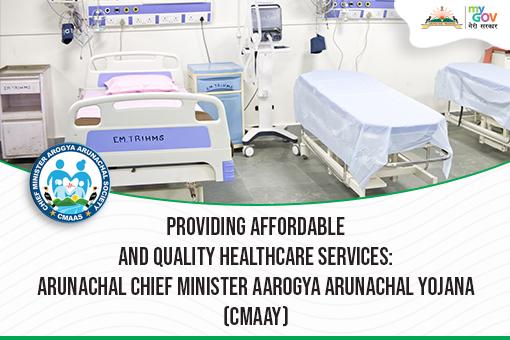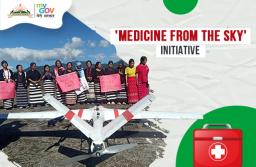Since its inception, the Chief Minister Arogya Arunachal Yojana, abbreviated as CMAAY, has been a great help to the citizens of Arunachal Pradesh. Launched on August 15th, 2018, this state government flagship program under the Department of Health and Family Welfare aims to deliver high-quality healthcare services to the indigenous people of the state, as well as the government employees by providing financial aid during major illness and hospitalization in the empanelled hospitals (across the country.)
CMAAY's main goal is to lessen the financial impact that medical conditions and hospital stays have on our citizens, the program guarantees that patients won't have to worry about the expenses of costly medical procedures out of their own pockets by offering cashless healthcare services. The program also focuses is ensuring that all lawful state residents have fair access to high-quality healthcare. This implies that everyone has a right to receive the same quality of healthcare treatments, irrespective of their social standing or financial situation. In terms of getting medical care, this guarantees that no one is left behind; fostering equality.
Furthermore, CMAAY has a big impact on improving the public health system's efficacy, efficiency, and self-reliance. The initiative aids the financial aspects of medical services by guaranteeing that claim refunds are immediately credited into the respective government hospital accounts. This transparency promotes more effective resource management, which eventually results in better healthcare services for everybody.
Last but not least, another objective of CMAAY is to close the gap between the state's secondary and tertiary healthcare systems. This means that people now have access to specialized medical services and treatments that had been previously inaccessible or limited. This initiative guarantees that those with critical medical illnesses receive the treatment they require by offering complete health care coverage.
The Chief Minister Arogya Arunachal Yojana has had a positive impact on the local citizens of Arunachal Pradesh who have applied and received the benefits under the scheme. Many testimony suggests that it has immensely reduced the financial burden on individuals during hospitalization, with access to inexpensive medicine (you can get it from PMAAY pharmacies) and high-quality medical services. It has indeed ensured equitable access to quality healthcare and made the public health system more efficient as well as bridged the gap in secondary and tertiary healthcare services. To avail the benefits of CMAAY, go to www.cmaay.com or download the app Arogya Arunachal, and follow the instructions for further process.
We invite citizens to discuss their experience with the CMAAY program. Tell us what you think the Government should do to make the healthcare system in the state better and affordable for all. Let's work together to make sure everyone gets exemplary medical care













BrahmDevYadav 1 year 4 months ago
What are the elements of patient care?
Research by the Picker Institute has delineated six dimensions of patient-centered care, including:-
1) Respect for the patient's values, preferences and expressed needs.
2) Information and education.
3) Access to care.
4) Emotional support to relieve fear and anxiety.
5) Involvement of family and friends.
6) Continuity.
BrahmDevYadav 1 year 4 months ago
How do we promote dignity in care?
1.Let people choose their own clothing.
2.Involve them in decisions relating to their care.
3.Address the person appropriately.
4.Make food look appealing and tasty.
5.Respect personal space and possessions.
6.Hygiene and personal care.
7.Promote social activities.
8.Engage in conversation.
BrahmDevYadav 1 year 4 months ago
What does NHS stand for?
The National Health Service is the umbrella term for the publicly funded healthcare systems of the United Kingdom, comprising the National Health Service in England, NHS Scotland and NHS Wales. Health and Social Care in Northern Ireland was created separately and is often locally referred to as "the NHS".
BrahmDevYadav 1 year 4 months ago
What is dignity in healthcare?
Care with dignity supports the self-respect of the person, recognising their capacities and ambitions and does nothing to undermine it. It includes respect for what they can do, who they are, and the life they have lived. It is seen as a central part of quality in care work.
BrahmDevYadav 1 year 4 months ago
What are quality indicators in hospitals?
1.Occupancy rate:- As its name suggests, this indicator traces the percentage of patients
seen according to the number of beds available.
2.Turnover interval.
3.Average length of stay.
4.Profitability.
5.Revenue.
6.Patient satisfaction.
7.Clinic's productivity evaluation.
BrahmDevYadav 1 year 4 months ago
What are the three models of care?
Some of the most commonly used models of care are the Health Home Model, the Special Needs Plan Model and the Chronic Care Model.
BrahmDevYadav 1 year 4 months ago
What is an indicator of quality of care?
Quality Indicators are standardized, evidence-based measures of health care quality that can be used with readily available hospital inpatient administrative data to measure and track clinical performance and outcomes.
BrahmDevYadav 1 year 4 months ago
What is an effective care plan?
The care plan must be tailored to the person, using language they understand with their preferences, their priorities and goals. Always avoid an overly standardised cookie-cutter approach. Care plans should include, What the assessed needs are. Strengths and wishes of the client.
BrahmDevYadav 1 year 4 months ago
What is clinically effective care?
Clinical effectiveness is a collection of activities and tools, based on research and measurement that are used to improve the quality of healthcare. The activities include but are not limited to guidelines, audit, research and evaluation.
BrahmDevYadav 1 year 4 months ago
Why is quality important in healthcare?
Quality measurement plays a crucial role in assessing and monitoring the performance of healthcare providers. These measures provide insights into the effectiveness, safety, patient-centeredness, timeliness, efficiency and equity of care.